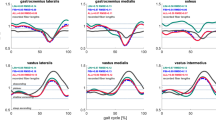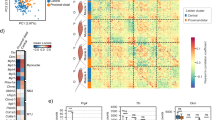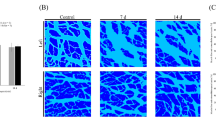Abstract
Study design:
Unrandomized trial.
Objectives:
To investigate the structural and functional relationships and the progression of muscle atrophy up to 20 years of spastic paraplegia.
Setting:
Clinical follow-up in Vienna, Austria; muscle biopsies analyzed by light microscopy in Padova and by electron microscopy (EM) in Chieti, Italy.
Methods:
Force was measured as knee extension torque; trophism by computer tomography scan; tissue composition and fiber morphology by histopathology and EM.
Results:
In the long-term group of patients (17.0±2.6 years), force and size of thigh muscles were only slightly different from those of mid-term subjects (2.2±0.5 years). Histology and ultrastructure confirm that the difference in average size of muscle fibers between long-term and mid-term paralyzed leg muscles is actually very small. In addition, muscle fibers maintain the striated appearance characteristic of normal skeletal fibers even after 14–20 years of paralysis. Ultrastructural alterations of the activating and metabolic machineries, and the presence of fibers with lower motor neuron denervation features, may explain the low-force output and the reduced endurance of paretic muscles.
Conclusion:
The stable muscle atrophy that characterizes long-lasting spastic paraplegia suggests that there are no upper-time limits to begin a training program based on functional electrical stimulation.
Similar content being viewed by others
Log in or create a free account to read this content
Gain free access to this article, as well as selected content from this journal and more on nature.com
or
References
Graupe D . An over view of the state of the art of non-invasive FES for independent deambulation by thoracic level paraplegics. Neurol Res 2002; 24: 431–442.
Kern H, McKay WB, Dimitrijevic MM, Dimitrijevic MR . Motor control in the human spinal cord and the repair of cord function. Curr Pharm Des 2005; 11: 1429–1439. Review.
Lieber RL, Steinman S, Barash IA, Chambers H . Structural and functional changes in spastic skeletal muscle. Muscle Nerve 2004; 29: 615–627.
Carlson MC, Borisov AB, Dedkov EI, Dow D, Kostrominov TY . The biology and restorative capacity of long-term denervated skeletal muscle. Basic Appl Myol 2002; 12: 47–254.
Carraro U . Modulation of trophism and fiber type expression of denervated muscle by different patterns of electrical stimulation. Basic Appl Myol 2002; 12: 263–273.
Midrio M . The denervated muscle: facts and hypotheses. A historical review. Eur J Appl Physiol 2006; 98: 1–21.
Kern H, Boncompagni S, Rossini K, Mayr W, Fanò G, Zanin ME et al. Long-term denervation in humans causes degeneration of both contractile and excitation–contraction coupling apparatus that can be reversed by functional electrical stimulation (FES). A role for myofiber regeneration? J Neuropath Exp Neurol 2004; 63: 919–931.
Carraro U, Rossini K, Mayr W, Kern H . Muscle fiber regeneration in human permanent lower motoneuron denervation: relevance to safety and effectiveness of FES-training, which induces muscle recovery in SCI subjects. Artif Organs 2005; 29: 187–191.
Modlin M, Forstner C, Hofer C, Mayr W, Richter W, Carraro U et al. Electrical stimulation of denervated muscles: first results of a clinical study. Artificial Organs 2005; 29: 203–206.
Lotta S, Scelsi R, Alfonsi E, Saitta A, Nicolotti D, Epifani P et al. Morphometric and neurophysiological analysis of skeletal muscle in paraplegic patients with traumatic cord lesion. Paraplegia 1991; 29: 247–252.
Scelsi R . Skeletal muscle pathology after spinal cord injury. Our 20-year experience and results on skeletal muscle changes in paraplegics, related to functional rehabilitation. Basic Appl Myol 2001; 11: 75–86.
Gorgey SA, Dudley GA . Skeletal muscle atrophy and increased intramuscular fat after incomplete spinal cord injury. Spinal Cord 2007; 45: 304–309; advance online publication, August 29, 2006; doi:10.1038/sj.sc.3101968.
Taylor PN, Ewins DJ, Fox B, Grundy D, Swain ID . Limb blood flow, cardiac output and quadriceps muscle bulk following spinal cord injury and the effect of training for the Odstock functional electrical stimulation standing system. Paraplegia 1993; 31: 303–310.
Giangregorio LM, Webber CE, Phillips SM, Hicks AL, Craven BC, Bugaresti JM et al. Can body weight supported treadmill training increase bone mass and reverse muscle atrophy in individuals with chronic incomplete spinal cord injury? Appl Physiol Nutr Metab 2006; 31: 283–291.
Andersen JL, Mohr T, Biering-Sørensen F, Galbo H, Kjaer M . Myosin heavy chain isoform transformation in single fibers from m. vastus lateralis in spinal cord injured individuals: effects of long-term functional electrical stimulation (FES). Pflugers Arch 1996; 431: 513–518.
Castro MJ, Apple Jr DF, Staron RS, Campos GE, Dudley GA . Influence of complete spinal cord injury on skeletal muscle within 6 mo of injury. J Appl Physiol 1999; 86: 350–358.
Crameri RM, Weston AR, Rutkowski S, Middleton JW, Davis GM, Sutton JR . Effects of electrical stimulation leg training during the acute phase of spinal cord injury: a pilot study. Eur J Appl Physiol 2000; 83: 409–415.
Adams MM, Ditor DS, Tarnopolsky MA, Phillips SM, McCartney N, Hicks AL . The effect of body weight-supported treadmill training on muscle morphology in an individual with chronic, motor-complete spinal cord injury: a case study. J Spinal Cord Med 2006; 29: 167–171.
Mohr T, Andersen JL, Biering-Sorensen F, Galbo H, Bangsbo J, Wagner A et al. Long-term adaptation to electrically induced cycle training in severe spinal cord injured individuals. Spinal Cord 1997; 35: 1–16.
Kern H, Hofer C, Mödlin M, Forstner C, Raschka-Högler D, Mayr W et al. Denervated muscles in humans: limitations and problems of currently used functional electrical stimulation training protocols. Artificial Organs 2002; 26: 216–218.
Rossini K, Zanin ME, Podhorska-Okolow M, Carraro U . Stage and quantify Regenerative Myogenesis in human long-term permanent denervated muscle. Basic Appl Myol 2002; 12: 277–286.
Rossini K, Biral D, Carraro U, Mayr W, Kern H . N-CAM and isomyosins of long-term denervated human muscle. Basic Appl Myol 2006; 16: 108–110.
Sanger JW, Sanger JM, Franzini-Armstrong C . Assembly of the skeletal muscle cell. In: Engel AG and Franzini-Armstrong C (eds). Myology, 3rd Edn. McGraw-Hill Med Publish Div: New York, 2004 Vol. 1, pp 45–65.
Franzini-Armstrong C . The membrane systems of muscle cells, In: Engel AG and Franzini-Armstrong C (eds). Myology, 3rd edn. McGraw-Hill Med Publish Div: New York, 2004 Vol. 2, pp 232–256.
Boncompagni S, d’Amelio L, Fulle S, Fanò G, Protasi F . Progressive disorganization of the excitation-contraction coupling apparatus in ageing human skeletal muscle as revealed by electron microscopy: a possible role in the decline of muscle performance. J Gerontol Biol Sci 2006; 61: 995–1008.
Ogata T, Yamasaki Y . Scanning electron-microscopic studies on the three-dimensional structure of mitochondria in the mammalian red, white and intermediate muscle fibers. Cell Tissue Res 1985; 241: 251–256.
Bolanos P, Guillen A, Rojas H, Boncompagni S, Caputo C . The use of CalciumOrange-5N as a specific marker of mitochondrial Ca(2+) in mouse skeletal muscle fibres. Pflugers Archiv. Eur J Physio 2007 (e-pub ahead of print: 18 August) PMID: 17705046.
Acknowledgements
We thank Katia Rossini, Valerio Gobbo, Susy Caccavale, Nicoletta Adami and Donatella Biral for morphometry of light microscopy analyses. This work was supported by the Austrian Ministry of Transport, Innovation and Technology ‘Impulsprogramm’ Grant No.: 805.353 and Otto Bock Healthcare Products GmbH Vienna, Austria; research funds from the Ludwig Boltzmann Institute for Electrostimulation and Physical Rehabilitation at the Institute of Physical Medicine and Rehabilitation (Wilhelminenspital, Vienna, Austria); the Italian C.N.R. funds and the Italian MIUR funds (ex60%) and PRIN 2004–2006 Program (Contract n. 2004061452-002) to UC; research funds from the University G d’Annunzio of Chieti to FP Sponsorship: Austrian Ministry of Transport, Innovation and Technology ‘Impulsprogramm’ Grant No.: 805.353 and Otto Bock Healthcare Products GmbH Vienna, Austria.
Author information
Authors and Affiliations
Corresponding author
Rights and permissions
About this article
Cite this article
Kern, H., Hofer, C., Mödlin, M. et al. Stable muscle atrophy in long-term paraplegics with complete upper motor neuron lesion from 3- to 20-year SCI. Spinal Cord 46, 293–304 (2008). https://doi.org/10.1038/sj.sc.3102131
Received:
Revised:
Accepted:
Published:
Issue date:
DOI: https://doi.org/10.1038/sj.sc.3102131
Keywords
This article is cited by
-
Assessment of renal function in persons with motor complete spinal cord injury—cystatin C as an accurate single marker
Spinal Cord (2024)
-
Intensity of overground robotic exoskeleton training in two persons with motor-complete tetraplegia: a case series
Spinal Cord Series and Cases (2023)
-
Quantitative ultrasound imaging of intrinsic hand muscles after traumatic cervical spinal cord injury
Spinal Cord (2022)
-
The beneficial aspects of spasticity in relation to ambulatory ability in mice with spinal cord injury
Spinal Cord (2020)
-
Mitochondrial health and muscle plasticity after spinal cord injury
European Journal of Applied Physiology (2019)



